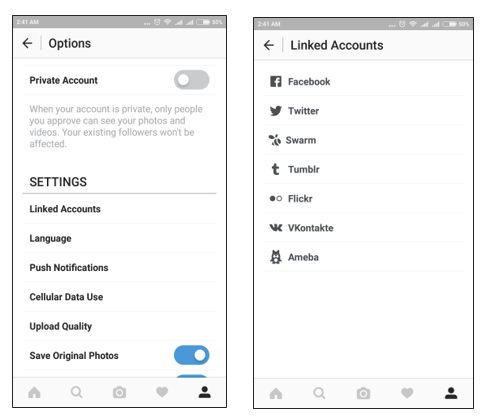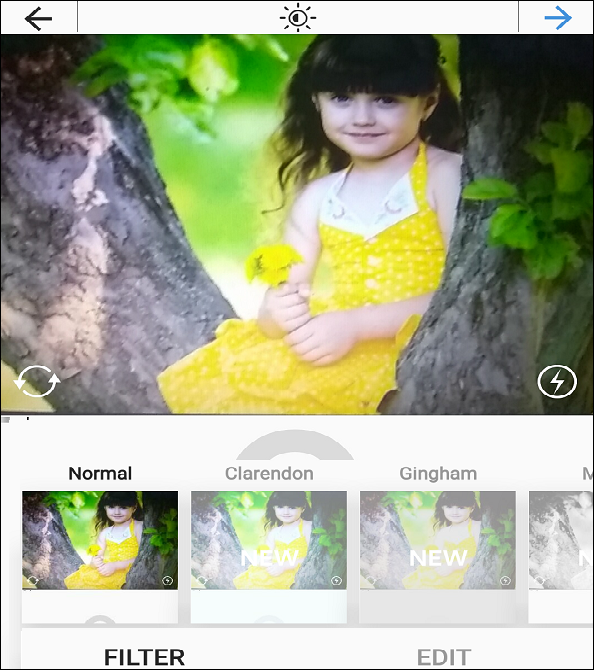On the grounds that Instagram is a moderately segregated social
application that lives inherently on mobile, it's essential to connect
social accounts to get the most out of the experience. You may choose to
link Instagram to your Facebook, Twitter, Foursquare, Tumblr, Flickr,
VK, Mixi and Weibo accounts.
 Each time you upload a photo to Instagram, you will have the option
to share to each of the social networks you have enabled, or to none of
them. If you choose to share to no social networks, the photo will post
only to Instagram, and will be viewed only by those users who follow you
on the application.
Each time you upload a photo to Instagram, you will have the option
to share to each of the social networks you have enabled, or to none of
them. If you choose to share to no social networks, the photo will post
only to Instagram, and will be viewed only by those users who follow you
on the application.
There are 17 famous Instagram filters which add different predetermined layers to your photos, and give them the desired effect. Scroll through the filters and select the best one for that particular image. Each filter has its own associated border.
 Some of the filters are −
Some of the filters are −
To create them you need to place # character before a keyword, or a phrase that you want to trigger when someone looks for something similar on the result pages. For example, you want people to see your images of green grass, you can utilize hashtag as #greengrass.
Some more intricate details on utilizing hashtags on Instagram are discussed below.
Your hashtags ought to be unique and easy to remember. Incorporate them in most of your Instagram posts related to your business. When you post content that is not related to business, then you do not need to use your business hashtags.
Rather, fusing less common hashtags will guarantee that your posts live more in the search items. Blending in a variety of less popular hashtags guarantees you the best of all.
Set the list with your center hashtags and basically copy and paste it into your Instagram post caption to save your typing time.
To add a location on Instagram, there is an option ‘add a location’ when you are uploading a new photograph. However, you can likewise add a location to a photo that you've already uploaded.
To edit a photo that you have already uploaded, just tap on the three dots below the photo and to the right. When you tap on the three dots, you will have an option to edit this photo. Then tap on Edit.
You will notice that at the top of the screen, there is a link that says ‘Add Location’. Tap on that link. Automatically, Instagram's going to try and search to find out what location you are currently at. But in case you are not at the location where the photograph was taken, you can search yourself in the search box at the top of the screen. After the search, tap on the search box and search for that location. Once the location appears, tap on it. Click Done to save the edit.
Linking Social Platforms
To connect social accounts, head to the Profile Tab → Edit Sharing Settings → Linked accounts, then choose the network which you wish to connect. Each time you upload a photo to Instagram, you will have the option
to share to each of the social networks you have enabled, or to none of
them. If you choose to share to no social networks, the photo will post
only to Instagram, and will be viewed only by those users who follow you
on the application.
Each time you upload a photo to Instagram, you will have the option
to share to each of the social networks you have enabled, or to none of
them. If you choose to share to no social networks, the photo will post
only to Instagram, and will be viewed only by those users who follow you
on the application.Adding Filters
After taking or selecting a photo, when you tap next, a set of three icons appears below the image. With the swipe of your finger, you can boost contrast, inject vintage flavor, or just enhance the overall effect of the picture. This not only transforms an ordinary snapshot into a photographic work of art, but it also increases the number of views and comments your post receives.There are 17 famous Instagram filters which add different predetermined layers to your photos, and give them the desired effect. Scroll through the filters and select the best one for that particular image. Each filter has its own associated border.
 Some of the filters are −
Some of the filters are −- Clarendon − Initially released as a video-only filter, Clarendon was later made accessible for photographs too. It escalates shadows and brightens highlights in your photographs.
- Gingham − Gingham is another previously video-only filter. When you use it for your photographs, it washes them out. If it is used with a darker photo, it gives a yellowish tone. If using it with a photo loaded with light, it gives a brighter, fantastic look.
- Moon − This filter was likewise actually meant just for video, and was named after an Instagram team member’s dog. Consider it as the black and white version of Gingham, with marginally more intense shadows.
- Lark − Lark enhances your images and intensifies all your colors, except red color.
- Ludwig − Ludwig is an intense filter. Warm colors are warmer, cool colors are darker, and shadows and highlights are comparatively more affirmed.
Utilizing Hashtags
Hashtag is a tag, label or metadata used on social media platforms to find a specific content. Hashtags are a path for individuals to look for media on social networks that have a common theme. It permits us to interface our posts on an all-around searchable subject. The purpose of utilizing hashtags is to make a more extensive span than you previously would have on your own.To create them you need to place # character before a keyword, or a phrase that you want to trigger when someone looks for something similar on the result pages. For example, you want people to see your images of green grass, you can utilize hashtag as #greengrass.
Some more intricate details on utilizing hashtags on Instagram are discussed below.
Use brand specific hashtags
Make one-of-a-kind hashtags for your brand or business. These ought to be something that represents what you do or characterizes you particularly.Your hashtags ought to be unique and easy to remember. Incorporate them in most of your Instagram posts related to your business. When you post content that is not related to business, then you do not need to use your business hashtags.
Combine popular and less common hashtags
While you may believe it's best to just use popular hashtags, this is a mistake. Yes, you need to utilize well-known hashtags to build your chances of appearing in popular searches. However, if it is a popular category and everyone else is doing the same thing then surely your post will vanish quickly into the depths of the search results.Rather, fusing less common hashtags will guarantee that your posts live more in the search items. Blending in a variety of less popular hashtags guarantees you the best of all.
Create lists of hashtags
On your device, you can also make a note with your top choice/favored hashtags. You can even make numerous lists if you have different sorts of content which you share on Instagram.Set the list with your center hashtags and basically copy and paste it into your Instagram post caption to save your typing time.
Monitoring Location Tags
If your organization has a brick and mortar location, it is an awesome thought to make use of Instagram's feature that permits you to tag a location for the photographs that you upload. When you tag a location on Instagram, individuals can search for all of the photos that have been tagged in that particular location, so it builds the visibility of your uploads because some person might just be browsing all of the photos in a particular location, discover your photo, and start following you on Instagram.To add a location on Instagram, there is an option ‘add a location’ when you are uploading a new photograph. However, you can likewise add a location to a photo that you've already uploaded.
To edit a photo that you have already uploaded, just tap on the three dots below the photo and to the right. When you tap on the three dots, you will have an option to edit this photo. Then tap on Edit.
You will notice that at the top of the screen, there is a link that says ‘Add Location’. Tap on that link. Automatically, Instagram's going to try and search to find out what location you are currently at. But in case you are not at the location where the photograph was taken, you can search yourself in the search box at the top of the screen. After the search, tap on the search box and search for that location. Once the location appears, tap on it. Click Done to save the edit.

No comments:
Post a Comment